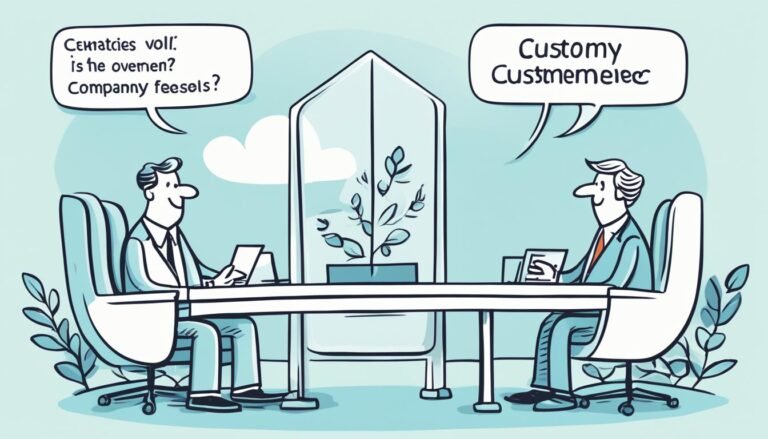Mastering Sales Presentation Psychology Tips
In the world of sales, understanding the psychology behind successful selling and mastering effective communication techniques are essential skills. Sales professionals who can connect with customers on a deeper level, build rapport, and establish trust are more likely to close deals and foster long-term relationships.
Key Takeaways:
- Effective sales presentation strategies rely on understanding buyer psychology in sales presentations.
- Influencing buying decisions involves utilizing persuasive communication techniques.
- Neuro-linguistic programming in sales presentations can enhance persuasion.
- Emotional intelligence plays a crucial role in building rapport with clients.
- Body language in sales presentations can significantly impact communication and connection with customers.
The Psychology Behind Successful Selling
Successful selling goes beyond simply presenting products or services. It involves understanding the psychological factors that influence customers’ decision-making processes. By adopting a customer-centric approach, sales professionals can enhance their sales performance and foster long-term customer relationships.
Understanding Customer Needs
In order to effectively sell to customers, it is crucial to understand their needs and desires. By listening actively and asking open-ended questions, sales professionals can gain insights into what motivates their customers and tailor their sales pitch accordingly. This customer-centric approach demonstrates empathy and builds trust, increasing the likelihood of closing the sale.
Emotional Intelligence
Emotional intelligence plays a key role in successful selling. Sales professionals who can understand and manage their own emotions, as well as attune to the emotions of their customers, are better equipped to build rapport and establish trust. By leveraging emotional intelligence, sales professionals can connect with customers on a deeper level and create a positive buying experience.
Social Proof and Influence
Utilizing social proof and influence can significantly impact customers’ decision-making processes. By showcasing testimonials, case studies, and endorsements from satisfied customers, sales professionals can provide social proof that their product or service delivers the desired outcomes. This builds credibility and increases the likelihood of a sale.
Loss Aversion
Loss aversion is a powerful psychological principle that motivates people to take action to avoid potential losses. By highlighting the potential losses or missed opportunities that customers may experience by not purchasing the product or service, sales professionals can create a sense of urgency and motivate customers to make a buying decision.
“Understanding customer needs, leveraging emotional intelligence, utilizing social proof and influence, and highlighting potential losses or missed opportunities are essential strategies for successful selling.”
By applying these psychological principles, sales professionals can enhance their sales presentations and increase their chances of closing deals. The combination of understanding customer needs, emotional intelligence, social proof and influence, and loss aversion creates a powerful sales strategy that resonates with customers and drives them towards a buying decision.
| Psychological Factors | Impact on Selling |
|---|---|
| Understanding customer needs | Allows for tailored sales pitches and builds trust |
| Emotional intelligence | Enhances rapport-building and creates a positive buying experience |
| Social proof and influence | Increases credibility and motivates action |
| Loss aversion | Creates a sense of urgency and drives customers towards a buying decision |
Effective Communication Techniques for Sales Professionals
In the world of sales, effective communication is key to building strong relationships with customers and closing deals. Sales professionals who can master the art of communication are better equipped to understand customer needs, convey the value of their offerings, and influence buying decisions. In this section, we will explore some powerful communication techniques that can help sales professionals excel in their roles.
The Power of Active Listening
Active listening is a vital skill that all sales professionals should develop. It involves fully focusing on and comprehending what the customer is saying, without interrupting or jumping to conclusions. By actively listening, sales professionals can gain deeper insights into customer needs and pain points, allowing them to tailor their approach and provide customized solutions. Active listening also demonstrates genuine interest in the customer, building trust and rapport.
Asking Open-Ended Questions
Asking open-ended questions is an effective way to encourage customers to share more information and express their thoughts and feelings. These questions require more than a simple “yes” or “no” answer and invite customers to provide detailed responses. By asking open-ended questions, sales professionals can uncover valuable insights, understand customer motivations, and tailor their sales pitch accordingly. This technique encourages meaningful conversations and shows customers that their opinions and input are valued.
Mirroring and Matching
Mirroring and matching is a technique where sales professionals subtly mirror the body language, tone of voice, and pace of the customer. This technique helps establish rapport and makes the customer feel more comfortable and understood. Mirroring and matching builds a sense of connection and helps the sales professional establish a positive working relationship with the customer.
The Power of Storytelling
Storytelling is a powerful tool that can captivate customers and engage them emotionally. Sales professionals can bring their products or services to life by sharing compelling stories that showcase real-life examples of how their offerings have made a difference for other customers. Stories create a personal connection, allow customers to visualize the benefits, and provide social proof of the product or service’s effectiveness. By incorporating storytelling into their sales presentations, professionals can leave a lasting impact on customers and increase the chances of closing the sale.
These communication techniques, encompassing active listening, asking open-ended questions, mirroring and matching, and storytelling, can greatly enhance sales professionals’ ability to connect with customers, understand their needs, and convey the value of their offerings. By mastering these techniques, sales professionals can build stronger relationships, foster trust, and ultimately achieve greater sales success.
Building Rapport and Establishing Trust with Customers
When it comes to successful sales relationships, building rapport and establishing trust are paramount. Sales professionals can achieve this by incorporating authenticity, empathy, consistency and reliability, as well as follow-up and support throughout the customer journey.
Authenticity is key in building rapport and gaining customers’ trust. Being genuine and transparent in your interactions allows customers to feel comfortable and confident in their decision to do business with you.
Showing empathy towards customers’ needs and concerns demonstrates that you genuinely care about their success. By understanding their pain points and providing solutions tailored to their specific requirements, you can establish a meaningful connection that fosters trust.
Consistency and reliability are essential traits for sales professionals. By consistently delivering on your promises and providing reliable information and assistance, you reinforce customers’ trust in your expertise and offerings.
Follow-up and support are crucial components of the sales process. By following up with customers promptly and providing ongoing support, you demonstrate your commitment to their success even after the initial sale. This level of dedication strengthens the relationship and solidifies the trust you have established.
“Trust is built with consistency.” – Lincoln Chafee
Building rapport and establishing trust with customers is a continuous process that requires effort and dedication. By incorporating authenticity, empathy, consistency and reliability, as well as follow-up and support, sales professionals can cultivate strong and long-lasting relationships that drive success.
Now, let’s take a look at some real-life examples of companies that have mastered the art of building rapport and establishing trust with their customers.
Companies that Excel in Building Rapport and Establishing Trust
| Company | Approach |
|---|---|
| Apple | Providing exceptional customer service and creating a user-friendly experience that empowers customers. |
| Zappos | Going above and beyond to exceed customer expectations, with a strong focus on building personal connections. |
| Amazon | Offering reliable and efficient logistics, seamless customer support, and a vast selection of products. |
Handle Objections Early
Addressing objections early in the sales process is crucial for ensuring a smooth and successful experience. By proactively handling objections, sales professionals can prevent confusion, clarify doubts, and increase the chances of closing the sale.
One common objection that arises during sales conversations is the involvement of decision makers. Many times, potential customers may express concerns about the decision-making process within their organization. By addressing this objection head-on, sales professionals can provide reassurance and build confidence in their ability to navigate these complexities. Demonstrating expertise in dealing with multiple decision makers can help alleviate concerns and strengthen the buyer’s trust in the proposed solution.
Another objection frequently encountered is when prospects respond with “I need to think about it.” This hesitation often arises due to a lack of clarity or uncertainty about the value proposition. By actively engaging with the prospect, asking probing questions, and understanding their specific concerns, sales professionals can address these objections effectively. Offering additional information, providing case studies, or sharing success stories can help overcome objections related to the need for more time to make a decision.
Remember: objections are not roadblocks; they are opportunities to provide further information and address concerns. By addressing objections early and with empathy, sales professionals can foster transparency, reduce barriers to decision-making, and increase their chances of closing a sale.
“The key to handling objections is to view them as a natural part of the sales process. By addressing objections proactively, you demonstrate your commitment to understanding the customer’s concerns and finding solutions that meet their needs.” – John Stevens, Sales Consultant
When objections are handled effectively, customers feel heard and understood. It is essential to maintain an open and empathetic approach throughout the objection-handling process.
Advantages of Handling Objections Early:
- Builds trust and credibility with the prospect
- Increases clarity and understanding of the product or service
- Reduces indecision and improves the likelihood of closing the sale
- Demonstrates expertise and problem-solving skills
Handling objections early in the sales process sets the foundation for a productive and successful conversation. By addressing concerns about decision makers and objections related to needing more time to make a decision, sales professionals can proactively engage with prospects, provide the necessary information, and establish confidence in the proposed solution. Remember, objections are an opportunity to understand the prospect’s needs better and build a stronger case for your product or service.
Be Prescriptive
When it comes to sales, the key to success lies in understanding your customers’ pain points and desires. Instead of immediately pitching your products or services, take the time to investigate what your customers truly need and want. By identifying their specific challenges and aspirations, you can prescribe tailored solutions that address their unique circumstances.
“A great salesperson is like a doctor who listens carefully to the patient’s symptoms, diagnoses the underlying problem, and then prescribes the appropriate treatment.”
By taking a prescriptive approach, you position yourself as a trusted advisor rather than a pushy salesperson. This builds rapport and trust with your customers, increasing the likelihood of closing the sale and establishing long-term partnerships.
Investigating Pain Points and Desires
To effectively prescribe solutions, you must first delve into your customers’ pain points and desires. Take the time to ask probing questions that uncover their challenges, frustrations, and aspirations. Active listening is crucial during this phase, as it allows you to truly understand their needs and concerns.
Once you have gathered the necessary information, analyze their pain points and desires to identify common patterns or themes. This will help you develop a comprehensive understanding of your target audience and tailor your solutions accordingly.
Prescribing Tailored Solutions
After thoroughly investigating your customers’ pain points and desires, it’s time to prescribe solutions that meet their specific needs. By aligning your offerings with their challenges and aspirations, you position yourself as a problem solver who can deliver tangible results.
When presenting your solutions, highlight how they address the specific pain points and desires you uncovered earlier. Use compelling storytelling techniques to paint a vivid picture of how your products or services can transform their situation and help them achieve their goals.
Remember to emphasize the unique benefits and advantages of your offerings, clearly demonstrating why they are the best fit for your customers’ needs. By showcasing the value and relevance of your solutions, you differentiate yourself from competitors and increase the chances of closing the sale.
| Benefits of Being Prescriptive | How It Helps |
|---|---|
| Builds Trust | Showcases your expertise and commitment to solving your customers’ problems. |
| Differentiates from Competitors | By offering tailored solutions, you stand out in a crowded market. |
| Increases Closing Rate | When customers see how your solutions directly address their pain points and desires, they are more likely to make a buying decision. |
| Fosters Long-Term Partnerships | By providing personalized solutions, you lay the foundation for a lasting relationship with your customers. |
Give Fewer Options
When it comes to making decisions, too many options can actually hinder customers rather than help them. The phenomenon known as analysis paralysis occurs when individuals are faced with an overwhelming number of choices, leading to a state of indecision. As a sales professional, it is important to understand the negative impact of analysis paralysis and how it can affect your customers’ buying journey.
Instead of bombarding customers with an extensive range of options, consider offering minimal choices that are carefully curated to meet their specific needs and preferences. By streamlining the decision-making process, you can help customers make quicker and more confident decisions.
Furthermore, providing recommendations based on your expertise and understanding of the customer’s needs can be highly beneficial. Utilize your knowledge and experience to guide customers towards options that align with their requirements, making it easier for them to make a final decision.
Benefits of Offering Minimal Options and Giving Recommendations:
- Reduces decision-making time
- Decreases the likelihood of analysis paralysis
- Increases customer confidence in their choice
- Enhances the perception of your expertise
- Improves the overall customer experience
By focusing on offering fewer options and providing recommendations, you can alleviate the burden of decision-making for customers and create a more streamlined and efficient sales process.
| Approach | Number of Options |
|---|---|
| Standard Approach | 10+ |
| Minimal Options Approach | 3-5 |
As shown in the table above, opting for the minimal options approach significantly reduces the number of choices presented to customers. This not only prevents analysis paralysis but also allows for a more focused and efficient decision-making process.
Remember, providing a concise range of options and giving recommendations based on your expertise can greatly enhance the customer experience and increase the likelihood of closing the sale.
Use Social Proof
When it comes to influencing a customer’s decision-making process, social proof is a powerful tool that sales professionals can leverage. By showcasing testimonials and evidence of positive results, you can increase your credibility as a trusted provider and sway potential clients towards making a purchase. Social proof serves as validation for your offerings, demonstrating that others have had positive experiences and achieved desired outcomes.
Testimonials from satisfied customers not only showcase the value of your product or service but also create a sense of trust and reliability. When prospects see that others have benefited from what you have to offer, they are more likely to believe in the positive results they can achieve as well.
“Working with [Real Brand Name] has been a game-changer for our business. Their expertise and innovative solutions have helped us increase our revenue by 30% in just a few months.” – John Smith, CEO of ABC Company
The power of social proof lies in its ability to tap into the psychological principle of conformity. People often look to the actions and choices of others when making decisions, especially when they are uncertain or have limited knowledge. By showcasing positive testimonials or case studies, you are providing potential clients with social proof that can influence their perception of your product or service.
In addition to testimonials, you can also utilize social proof by highlighting endorsements from industry experts or well-known brands. By associating your offerings with respected and recognizable names, you further enhance your credibility and influence potential customers’ decision-making.
The Impact of Social Proof:
- Increases credibility and trust
- Reduces skepticism and doubt
- Creates a sense of security and confidence
- Builds emotional connection with potential customers
- Increases conversion rates and sales
By strategically incorporating social proof into your sales presentation, you can effectively tap into the power of influence and persuasion. Utilize testimonials, case studies, and endorsements to demonstrate the positive results your product or service has delivered for others. Remember, a satisfied customer’s endorsement can be one of your most valuable selling tools, providing the social proof needed to convince potential clients of the value you can bring to their lives or businesses.
Use Deadlines
When it comes to motivating customers to take action, deadlines can be a powerful tool. By creating a sense of urgency, sales professionals can instill a fear of missing out and prompt potential clients to make a purchasing decision promptly.
Legitimate deadlines serve as a reminder that time is limited, creating a sense of urgency and encouraging customers to act quickly. Whether it’s a limited-time offer, a special discount, or an upcoming event, deadlines can be used to create a sense of urgency that compels customers to make a buying decision.
By utilizing deadlines effectively, sales professionals can tap into the fear of missing out (FOMO) phenomenon. FOMO is a psychological state in which individuals feel anxious or afraid of missing out on an opportunity or experience. By leveraging this fear, sales professionals can motivate customers to take action and seize the opportunity before it’s too late.
Here’s an example of how a legitimate deadline can create urgency and drive sales:
“Don’t miss out on our exclusive offer! Purchase our product before [deadline date] to enjoy a 30% discount. Limited stock available. Act now and seize this opportunity to save big!”
By incorporating deadlines into sales presentations, sales professionals can create a sense of urgency, evoke fear of missing out, and encourage customers to make timely decisions.
Make It About Them
Sales professionals who truly understand the value of a customer-centric approach have a higher chance of closing the sale. By shifting the focus to understanding the customer’s perspective, needs, pain points, and desires, sales professionals can establish a deeper connection and demonstrate the relevance of their product or service.
When engaging with customers, it is important to actively listen and empathize with their challenges. By acknowledging their pain points and desires, sales professionals can position themselves as problem solvers and build trust.
One effective technique is to link the customer’s pain points and desires to the benefits of the product or service. By highlighting how the offering addresses their specific needs, sales professionals can showcase the value and impact it can have on their lives or businesses.
Remember, the customer-centric approach is not just about talking; it also involves asking the right questions to gain a deep understanding of the customer’s needs. This allows sales professionals to tailor their solutions and recommendations accordingly, positioning themselves as trusted advisors.
Ultimately, by embracing a customer-centric approach, sales professionals can demonstrate their commitment to meeting customer expectations, establishing long-term relationships, and increasing the likelihood of closing the sale.
| Benefits of a Customer-Centric Approach | Examples |
|---|---|
| Increased customer satisfaction and loyalty | Example: Repeat purchases and positive reviews/feedback |
| Higher conversion rates | Example: More prospects becoming paying customers |
| Stronger relationships with customers | Example: Open communication, trust, and collaboration |
| Improved brand reputation | Example: Word-of-mouth recommendations and referrals |
| Increased customer lifetime value | Example: Cross-selling and upselling opportunities |
By adopting a customer-centric approach, sales professionals can tap into the power of understanding the customer’s perspective, pain points, and desires. This ensures their sales conversations are personalized, relevant, and impactful, resulting in increased trust, improved conversions, and long-term customer loyalty.

Conclusion
To succeed in sales, mastering sales presentation psychology is crucial. By understanding the psychological factors that influence customers’ buying decisions, sales professionals can tailor their strategies to be more persuasive and effective.
Effective communication techniques play a significant role in building trust and rapport with customers. Active listening, asking open-ended questions, mirroring and matching, and incorporating storytelling all contribute to engaging customers emotionally and demonstrating the value of the products or services being offered.
Handling objections is another essential aspect of the sales process. Addressing objections early and providing clear and compelling responses can help overcome customer hesitations and increase the chances of closing the sale.
Utilizing social proof is a powerful tool in sales. Testimonials and evidence of positive results can enhance credibility and influence customers’ decision-making processes, while creating a sense of urgency through legitimate deadlines can motivate customers to take action.
A customer-centric approach is vital in sales presentations. By understanding customer needs and linking them to the benefits of the products or services, sales professionals can make the conversation more meaningful and increase the likelihood of closing the sale.
In conclusion, mastering sales presentation psychology requires a combination of sales psychology strategies, effective communication techniques, building trust and rapport, handling objections, utilizing social proof, creating urgency, and adopting a customer-centric approach. By incorporating these elements into their sales approach, professionals can enhance their sales performance and build long-lasting customer relationships.







